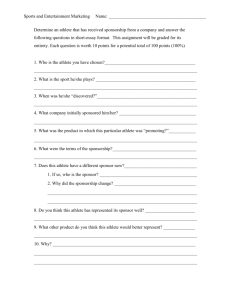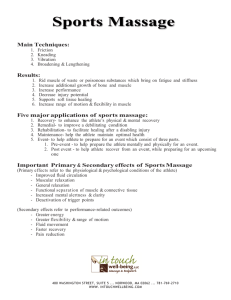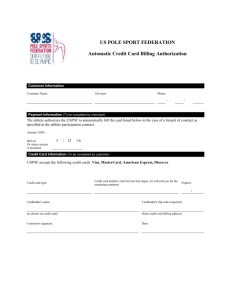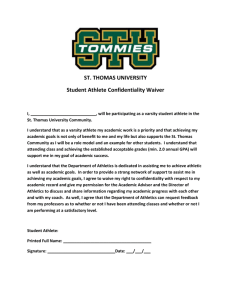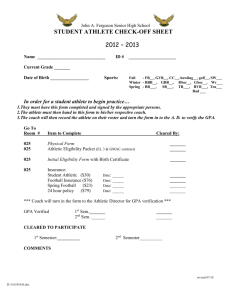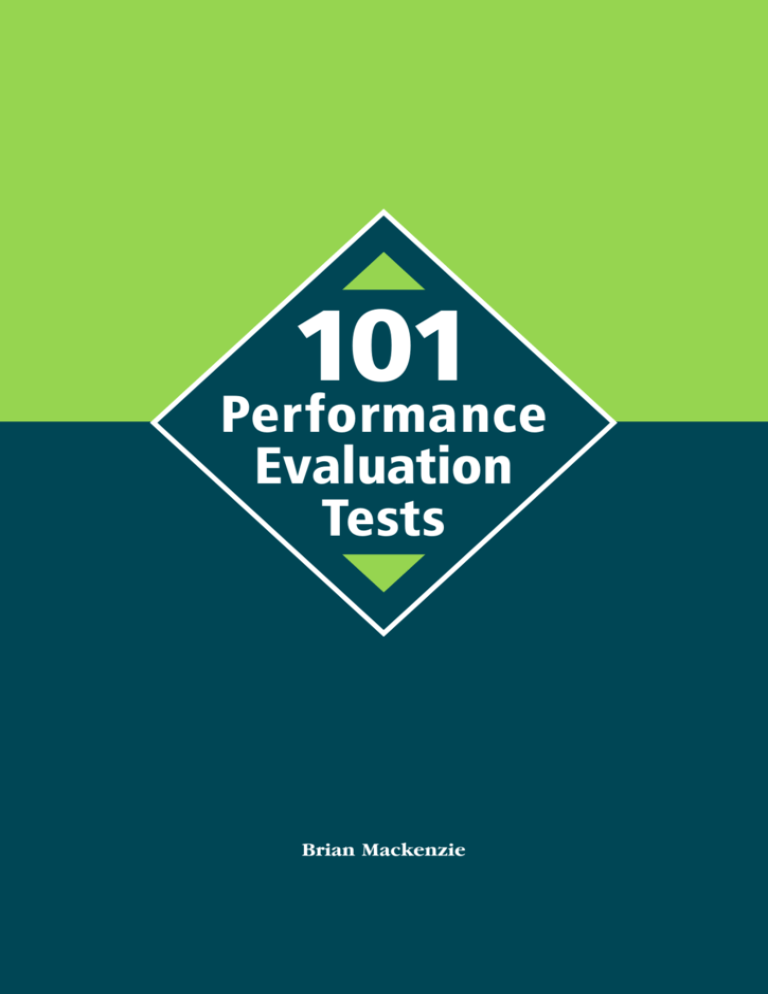
101
Performance
Evaluation
Tests
Brian Mackenzie
i
© Electric Word plc 2005
All rights reserved. No part of this publication may be
reproduced, stored in a retrieval system, or transmitted, in any
form or by any means, electronic, mechanical, photocopying,
recording or otherwise without the permission of the publishers.
The information contained in this publication is believed to be
correct at the time of manufacture. Whilst care has been taken to
ensure that the information is accurate, the publisher can accept
no responsibility for any errors or omissions or for changes to
details given.
Any application of the information provided in this workbook
is at the athlete’s own discretion and risk.
A CIP catalogue record for this book is available from the
British Library.
Publisher:
Jonathan Pye
jonathan.pye@electricwordplc.com
Editor:
Brian Mackenzie
brian@brianmac.demon.co.uk
Designer:
The Flying Fish Studios Ltd
www.the-flying-fish.com
Published by:
Electric Word plc
67-71 Goswell Road
London EC1V 7EP
Tel: 0845 450 6402
Registered number: 3934419
ISBN: 1-905096-18-6
iii
Contents
Introduction
vii
1
1
3
5
7
9
11
12
15
17
20
22
24
26
28
31
33
35
37
39
41
44
47
49
51
52
2
Endurance
1.1 Astrand Treadmill Test
1.2 Balke Treadmill Test
1.3 Balke VO2max Test
1.4 Bruce Treadmill Test
1.5 The 2.4 kilometre Run Test
1.6 Conconi Test
1.7 Cooper VO2max Test
1.8 Critical Swim Speed
1.9 Harvard Step Test
1.10 Astrand Cycle Test
1.11 Home Step Test
1.12 Three Minute Step Test
1.13 Multi-Stage Fitness Test
1.14 Queen’s College Step Test
1.15 Rockport Fitness Walking Test
1.16 Tecumseh Step Test
1.17 Treadmill VO2max Test
1.18 VO2max from a One Mile Jog
1.19 VO2max from Non-exercise Data
1.20 Running-based Anaerobic Sprint Test (RAST)
1.21 Tri-level Aerobic Test
1.22 Tri-level Lactic Power Test
1.23 Tri-level Alactic Power Test
1.24 Cunningham and Faulkner Test
Agility
2.1 Hexagonal Obstacle Test
2.2 Zig-Zag Test
2.3 505 Agility Test
2.4 Illinois Agility Run Test
2.5 Lateral Change of Direction Test
2.6 Quick Feet Test
55
57
59
60
62
64
66
iv
2.7
2.8
3
4
5
Burpee Test
‘T’Drill test
Mobility and Balance
3.1 Modified Sit & Reach Test
3.2 Sit and Reach Test
3.3 Hip Flexion Test
3.4 Static Flexibility Test – Ankle
3.5 Static Flexibility Test – Hip and Trunk
3.6 Static Flexibility Test – Shoulder
3.7 Static Flexibility Test – Shoulder & Wrist
3.8 Static Flexibility Test – Trunk and Neck
3.9 Trunk Flexion Test
3.10 Standing Stork Test
3.11 Standing Stork Test – Blind
Body Composition
4.1 Body Mass index
4.2 Body Fat Percentage
4.3 Jackson and Pollock Skinfold Test
4.4 Yuhasz Skinfold Test
Strength
5.1 Core Muscle Strength and Stability Test
5.2 Curl Up Test
5.3 Canadian Crunch Test
5.4 Sit Ups Test
5.5 Jumps Decathlon
5.6 Leg Strength Test
5.7 Standing Long Jump Test
5.8 Sprint Bound Index Test
5.9 Sergeant Jump Test
5.10 Chin Up Test
5.11 Grip Strength Test
5.12 Medicine Ball Javelin Quadrathlon
5.13 Press-ups Test
5.14 Bench Press Test
5.15 Universal Bench Press Test
5.16 Metronome Bench Press Test
5.17 Overhead Press Test
5.18 Leg Press Test
5.19 Leg Curl Test
5.20 Dynamic Knee Extension Test
68
70
73
74
76
78
79
81
83
85
87
89
91
93
95
96
98
102
105
109
111
113
115
117
119
122
124
126
128
130
132
134
137
140
143
144
146
148
150
152
v
5.21
5.22
5.23
5.24
5.25
5.26
5.27
5.28
6
Biceps Curl Test
Squats Test
Handgrip Strength Test
Flexed Arm-Hang Test
Wall Squat Test
The McCloy Physical Fitness Test
The Quadrathlon
The Wilf Paish Rugby Football Tests
Speed and Power
6.1 10 Stride Test
6.2 30 metre Acceleration Test
6.3 60 metre Speed Test
6.4 Shuttle Run Test
6.5 150 metre Endurance Test
6.6 250 metre Endurance Test
6.7 400 metre Sprint Test
6.8 300 yard Shuttle Test
6.9 400 metre Drop Off Test
6.10 Margaria-Kalamen Power Test
6.11 400 metre Control Tests
6.12 40 metre Sprint Test
6.13 30 metre Sprint Fatigue – Power Maintenance Test
6.14 Concept 2 Rowing Step Test
6.15 Flying 30 metre Test
6.16 Kosmin Test
6.17 The LAS (Lactic vs. Speed) Test
6.18 PWC-170 Cycle Test
6.19 The Wingate Anaerobic 30 cycle Test
6.20 35 metre Speed Test
6.21 Multiple Sprint Test
154
156
158
159
161
163
165
168
171
172
174
176
178
180
182
184
185
186
188
190
192
193
195
197
199
201
203
205
208
210
7
Sports Psychology
7.1 Sport Competition Anxiety Test (SCAT)
7.2 TEOSQ – Task and Ego Orientation in Sport Questionnaire
213
214
216
8
General Health
8.1 Orthostatic Heart Rate Test
8.2 Urine Colour Measurement
8.3 Waist to Hip Ratio Evaluation Test
219
220
222
224
Appendix A – VO2max Tables
226
vii
Introduction
The success of a training program is largely dependent upon satisfying the
performance aims associated with it and evaluation (testing and measuring) is
the means of collecting information upon which subsequent performance
evaluations and decisions can be made.
In constructing a test it is important to make sure that it really measure the
factors required to be tested, and is thus objective rather than subjective. In
doing so all tests should therefore be specific (designed to assess an athlete's
fitness for the activity in question), valid (test what they purpose to test),
reliable (capable of consistent repetition) and objective (produce a consistent
result irrespective of the tester).
Evaluation tests can be broken down into two main types: Maximal tests,
where the athlete works at maximum effort or tested to exhaustion, and SubMaximal tests, where the athlete works below maximum effort and
extrapolation is used to estimate maximum capacity.
The results from an evaluation test can be used to:
4 predict future performance
4 indicate weaknesses
4 measure improvement
4 enable the coach to assess the success of the training program
4 place the athlete in appropriate training group
4 motivate the athlete.
It is important to bear in mind that there are many factors that can influence
the outcome of an evaluation test – they include:
4 the ambient temperature, noise level and humidity
4 the amount of sleep the athlete had prior to testing
4 the athlete's emotional state
4 medication the athlete may be taking
4 the time of day
4 the time since the athlete's last meal
4 the test environment – surface (track, grass, road, gym)
4 the athlete's prior test knowledge/experience
viii
4
4
4
4
4
accuracy of measurements (times, distances etc)
is the athlete actually applying maximum effort in maximal tests
inappropriate warm up
people present
the personality, knowledge and skill of the tester.
As a coach I regularly test my athletes to ensure that their training program is
achieving the performance objectives. On the following pages you will find a
selection of evaluation tests for endurance, agility, mobility & balance, body
composition, strength, speed & power and sports psychology that I have
gathered and developed over the years and which I hope you will find beneficial
in monitoring your athlete’s or your athletic development.
Please let me know how you get on!
Best wishes
Brian Mackenzie
Editor
brian@brianmac.demon.co.uk




